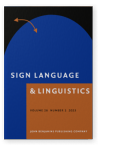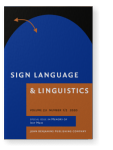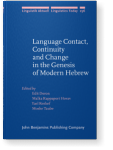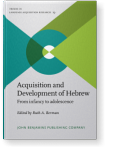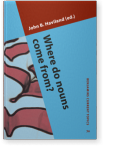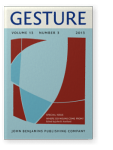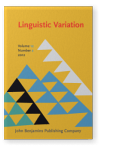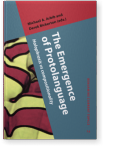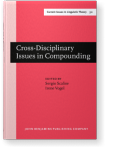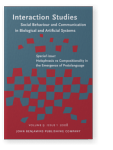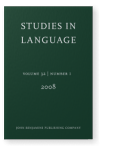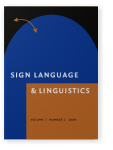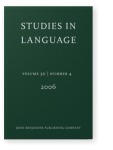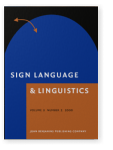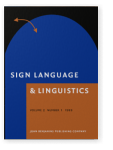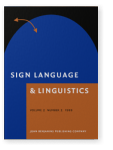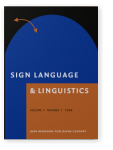Irit Meir
List of John Benjamins publications for which Irit Meir plays a role.
2023 Variation of sign parameters in narrative and expository discourse: A view from Israeli Sign Language Sign Language & Linguistics 26:2, pp. 218–257 | Article
The paper presents an in-depth study of variation in sign parameters of Israeli Sign Language (ISL). We describe and analyze specific sign parameters and their sub-parameters: handshape, orientation, place of articulation, and movement, as they are distributed in two text-types: narrative and… read more
2020 Topic-open-endedness: Why recursion is overrated Special Issue in Memory of Irit Meir, Lillo-Martin, Diane, Wendy Sandler, Marie Coppola and Rose Stamp (eds.), pp. 258–271 | Article
Humans can use language to refer to and describe endless varieties of situations, thoughts, ideas, and topics, actual or hypothetical. This capacity, which distinguishes human language from communication systems of other animals, is referred to here as topic-open-endedness. A key factor in… read more
2020 Visual foreign accent in an emerging sign language Special Issue in Memory of Irit Meir, Lillo-Martin, Diane, Wendy Sandler, Marie Coppola and Rose Stamp (eds.), pp. 233–257 | Article
In the study of sign language phonology, little attention has been paid to the phonetic detail that distinguishes one sign language from another. We approach this issue by studying the foreign accent of signers of a young sign language – Al-Sayyid Bedouin Sign Language (ABSL) – which is in… read more
2019 Variation and conventionalization in language emergence: The case of two young sign language of Israel Language Contact, Continuity and Change in the Genesis of Modern Hebrew, Doron, Edit, Malka Rappaport Hovav, Yael Reshef and Moshe Taube (eds.), pp. 337–364 | Chapter
Languages are constantly formed and changed by the opposing forces of variation and conventionalization. Yet it is not clear whether one of the two forces is prior to the other in language emergence, nor do we know how the two interact early in the life of a language. By comparing two young sign… read more
2016 Expression of temporality in Hebrew narratives written by deaf adolescents Acquisition and Development of Hebrew: From infancy to adolescence, Berman, Ruth A. (ed.), pp. 295–324 | Article
The chapter examines how temporal relations are expressed in narratives written by deaf compared with hearing Hebrew-speaking adolescents. Written texts of deaf students manifest distinct characteristics, attributable to the different circumstances of acquisition of spoken language in the two… read more
2015 Patterned iconicity in sign language lexicons Where do nouns come from?, Haviland, John B. (ed.), pp. 43–63 | Article
Iconicity is an acknowledged property of both gesture and sign language. In contrast to the familiar definition of iconicity as a correspondence between individual forms and their referents, we explore iconicity as a shared property among groups of signs, in what we call patterned iconicity. In… read more
2013 Patterned iconicity in sign language lexicons Where do nouns come from?, Haviland, John B. (ed.), pp. 287–308 | Article
Iconicity is an acknowledged property of both gesture and sign language. In contrast to the familiar definition of iconicity as a correspondence between individual forms and their referents, we explore iconicity as a shared property among groups of signs, in what we call patterned iconicity. In… read more
2012 The influence of community on language structure: Evidence from two young sign languages Linguistic Variation 12:2, pp. 247–291 | Article
By comparing two sign languages of approximately the same age but which arose and developed under different social circumstances, we are able to identify possible relationships between social factors and language structure. We argue that two structural properties of these languages are related to… read more
2010 The roots of linguistic organization in a new language The Emergence of Protolanguage: Holophrasis vs compositionality, Arbib, Michael A. and Derek Bickerton (eds.), pp. 133–152 | Article
It is possible for a language to emerge with no direct linguistic history or outside linguistic influence. Al-Sayyid Bedouin Sign Language (ABSL) arose about 70 years ago in a small, insular community with a high incidence of profound prelingual neurosensory deafness. In ABSL, we have been able to… read more
2010 Sign languages and compounding Cross-Disciplinary Issues in Compounding, Scalise, Sergio and Irene Vogel (eds.), pp. 301–322 | Article
Compounding is one of the few sequential word formation processes found across sign languages. We explore familiar properties of compounds in established sign languages like American Sign Language, as well as a modality-specific type of simultaneous compounding, in which each hand contributes a… read more
2008 The roots of linguistic organization in a new language Holophrasis vs Compositionality in the Emergence of Protolanguage, Arbib, Michael A. and Derek Bickerton (eds.), pp. 133–153 | Article
It is possible for a language to emerge with no direct linguistic history or outside linguistic influence. Al-Sayyid Bedouin Sign Language (ABSL) arose about 70 years ago in a small, insular community with a high incidence of profound prelingual neurosensory deafness. In ABSL, we have been able to… read more
2008 Sentence-phrase coordination in Hebrew and the syntax–pragmatics interface Studies in Language 32:1, pp. 1–21 | Article
The coordination of a sentence and a phrase (Sentence-Phrase coordination, henceforth SPC) is a very widespread, though marked, construction in Modern Hebrew. It is characterized by special prosody in that it carries two sentential stresses, and is perceived as more forceful or emphatic than its… read more
2006 Question and Negation in Israeli Sign Language Sign Language & Linguistics 7:2, pp. 97–124 | Article
The paper presents the interrogative and negative constructions in Israeli Sign Language (ISL). Both manual and nonmanual components of these constructions are described, revealing a complex and rich system. In addition to the basic lexical terms, ISL uses various morphological devices to expand… read more
2006 Morphological levels and diachronic change in Modern Hebrew plural formation Studies in Language 30:4, pp. 777–806 | Article
Modern Hebrew (MH) is undergoing a change in its morphological structure. Unlike earlier periods of the language, in which all nominal suffixation processes resulted in stress shift to the suffix, MH has a few suffixes that exhibit variable behavior. When attached to canonical bases, they pattern… read more
1999 A Perfect Marker in Israeli Sign Language Sign Language & Linguistics 2:1, pp. 43–62 | Article
In this paper I argue for the existence of an aspectual marker in Israeli Sign Language (ISL) denoting perfect constructions. This marker is the sign glossed as ALREADY. Though this sign often occurs in past time contexts, I argue that it is a perfect-aspect marker and not a past tense marker. This… read more
1999 Thematic structure and verb agreement in Israeli Sign Language Sign Language & Linguistics 2:2, pp. 263–270 | Miscellaneous
1998 Syntactic-semantic interaction in Israeli Sign Language verbs: The case of backwards verbs Sign Language & Linguistics 1:1, pp. 3–37 | Article
Previous studies of various sign languages have identified several classes of verbs which differ from each other on the basis of which agreement affixes can be attached to them. This paper focuses on one group of verbs, which inflect for person and number (i.e. agreement verbs, using Padden’s 1990… read more
